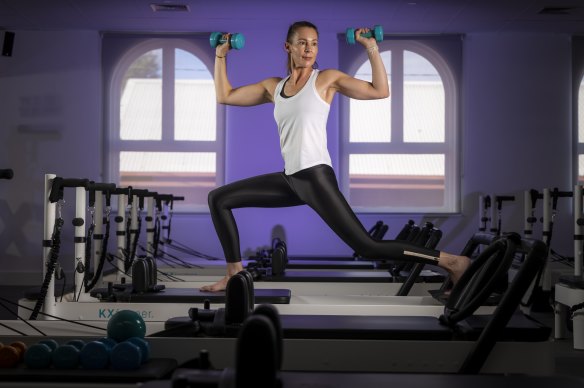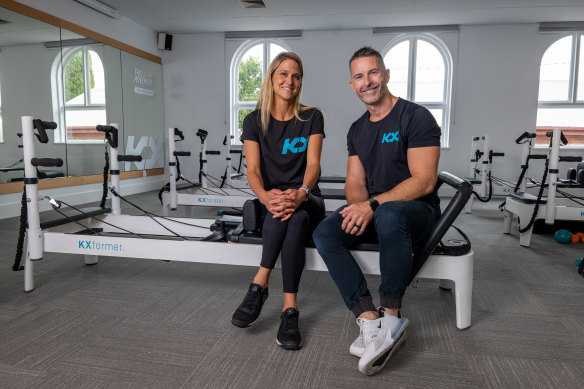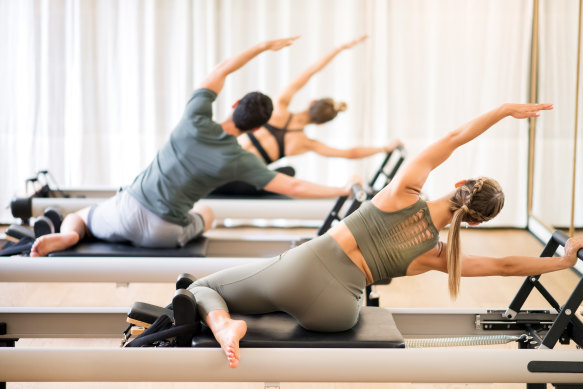Hitting the hundred: The rise, and risks, of ‘fitness’ Pilates
Thirteen years ago, on his first day of business, not a single person came through Aaron Smith’s doors in Melbourne’s Malvern.
The sports scientist and personal trainer had just returned from London, where he had first learnt of studio-based reformer Pilates.
Kate Pennell, a flight attendant, says Pilates has helped with the physical demands of her work.Credit:Wayne Taylor
Back home in Australia, Pilates was still mostly a rehabilitation practice available through physiotherapy clinics. No-one was using reformer beds. But, Smith was keen to replicate the boutique studios he had seen becoming popular in London and New York and take the practice to the general population.
He made a business proposal to his father who, one week later, accompanied him to the bank and acted as guarantor on a $130,000 loan. Six months later, Smith opened the doors of the first KX studio (for “the Kaizen experience”; Kaizen means “continuous improvement” in Japanese), a high-intensity reformer-based Pilates studio.
The first year was gruelling. Smith, then 27, felt his proximity to failure and woke each morning unsure of which direction it would go. It was, he admits, scary.
Slowly, with his parents’ encouragement and help to wash and fold towels, as well as group deal class passes to spread the word, the business started to grow. Today, KX Pilates has announced the opening of its 100th studio, in Noosa.
KX Pilates CEO Selena Bridges and founder Aaron Smith.
Since the 2010s, Pilates has grown in lockstep with yoga and the boutique functional fitness movement. Designed to help injured World War I veterans recover, it is now practised by everyone from the Australian Ballet to the Sydney Roosters. Influencers on social media, draping sleek limbs over reformer beds, have also propelled its popularity particularly among women, who account for as many as 90 per cent of participants.
Laura Bullock, a former dancer who used Pilates to recover from a back injury, has just opened her second Mode Pilates studio, in Sydney’s Mosman. Within a kilometre of Bullock’s studio are at least 15 competitors, including LagreeFit, Club Pilates, Fitness First and KX. She thinks the popularity of the practice means there is room for everyone. “There are a lot of different styles out there within the category,” she says.
Regardless of the style people choose, they tend to come for similar reasons: whether they are a runner, footy player, or dancer, it improves their performance.
“It targets all the supporting muscles that they don’t always get to work out,” Bullock says. “Strengthening those teeny muscle groups is really changing their game.”
And, says Smith, for those who don’t enjoy traditional exercise, boutique classes like Pilates can provide a sense of community. “People were sick of being a number [in a gym]. They wanted to be known as a person,” he says.
The research into the effects of Pilates is limited, but there is some evidence it improves flexibility, abdominal and lumbo-pelvic stability and strength.
There is also some evidence personalised programs can provide faster functional recovery in the early stage of rehabilitation as general exercises.
But some industry figures believe the commodification of fitness, including Pilates, has led to a situation where not all instructors are adequately qualified, and larger classes can reduce teachers’ capacity to supervise proper technique.
A decade ago, Pilates was a relatively niche mode of fitness in Australia. Now, it is one of the most practised activities in the country.Credit:iStock
Sharan Simmons, from the Pilates Alliance of Australasia, says, “because there is no regulation of Pilates, our association is fighting hard to set standards. Currently, Pilates training courses can last from a couple of hours or days to a year. A course with a minimum of 500 hours is needed for an instructor to have a comprehensive understanding of Pilates.”
Lyz Evans, founder of Women In Focus Physiotherapy clinics, adds that, as a physiotherapist, she has become concerned by what she has seen in her practice as “fitness” Pilates has flourished.
Fitness Pilates (as opposed to clinical Pilates, which is usually performed under the supervision of a physiotherapist, or clinical Pilates instructor), which focuses on high reps, and putting the muscle under a moderate load using springs, bands and balls for the entire class, can be great for toning, but can come with issues. If the muscles aren’t put through their full range of motion and given enough time to release and unwind, it can result in glute, hip and lower back tightness and pain, Evans warns.
It can also lead to extreme tightening of the pelvic floor muscles: “When this occurs in the pelvic floor it is not uncommon that pain with intercourse, pain with tampons, increased pain related to periods, incontinence, and obstructed defecation to commence,” Evans explains.
Andrea Mosler, a specialist sports physiotherapist at La Trobe University, says such an extreme response is unlikely, unless there is another underlying issue. She added: “I am more concerned about the hip flexor tendon pain from all the long-lever leg motions in Pilates when the lower abdominals are not strong enough to support neutral pelvic position.”
For these reasons, physios encourage people to ensure instructors are well-trained; speak with a physiotherapist first if you have any injuries, are pregnant or post-natal; and remember that balance is key.
“Our bodies love to move in all different ways, so a weekly exercise program should include a mix of toning, cardio, mobility and stretching, so ensure you are creating that balance to help prevent and address issues,” she says.
At KX, CEO Selina Bridge says people pay for the premium environment but won’t stay if the quality of the workout and the calibre of the instructor is not up to scratch: “If brands open just on the aesthetic, they’re not going to succeed … The workout is number one.”
Kate Pennell, 46, started Pilates in 2016. The flight attendant has recently completed her 1000th class. “I don’t like gyms, but I love Pilates,” says the Melburnian, who attends at least three classes a week. “Pilates is more interactive, and it doesn’t feel like a workout because it’s actually fun.”
It has also supported her to do her work. “It’s strengthened my core, which is protective because I work in confined spaces and I do a lot of heavy lifting and bending,” she says.
And though there’s a new fitness trend a minute and overnight, yesterday’s stars might find themselves tossed on the fitness dust heap alongside a million unwanted Tae Bo videos, Smith hopes the Pilates revolution is here to stay.
“One hundred studios was never on the cards 13 years ago,” says Smith. “But our purpose is to change lives for better.”
Make the most of your health, relationships, fitness and nutrition with our Live Well newsletter. Get it in your inbox every Monday.
Most Viewed in Lifestyle
From our partners
Source: Read Full Article



